
19 minute read
Products
Achieving Net Zero on new and existing homes also relies on good quality products. This section explains the level of performance to require from products which will help to reduce energy use and generate renewable energy.
Window types Window performance will vary greatly and is not always immediately apparent from their external appearance – or even price.
Key selection criteria Glazing U-value - This is an indication of the ability of the glazing itself to retain heat. For double glazing, this should be 1.3 W/m2K or lower. For triple glazing you should expect 0.6 W/m2K or lower. Frame type - The frame is an important part of the window’s thermal performance. Generally, it is best to avoid metal frames unless they have a dedicated thermal break. Timber frames offer good levels of performance and are a good option in most cases and can be clad in aluminium if required. If you can find out the frame U-value, it should be ideally less than 1.6 W/m2K. Whole window U-value - Sometimes, manufacturers do not provide a separate glazing and frame U-value and will only provide a U-value for the whole window. If this is the case, aim for <1.4 W/m2K for double glazed and <0.85 W/m2K for triple glazed. Window design - For most types of frame, the frame performance will be worse than the glazing performance. This means that we should try and minimise the amount of frame – including mullions and transoms –to make the window as efficient as possible. This will also improve the amount of daylight entering the building. Airtightness - The way in which the window’s closing mechanism works, combined with the design of the opening sash sections will influence how good the window will be at keeping out draughts. Look for a multi-point mechanism with two separate seals – this will help with security as well as airtightness. Ask if the window has an airpermeability test rating – if it does, it should be Class 4.
(Watts)
2 Heat loss through 1m 90
80
70
60
50
40
30
20
10
0
Solid brick wall
Cavity Wall with 50 mm fill
Cavity Wall with 90mm PIR fill Single Glazed Timber Frame Double Glazed Metal Frame Double Glazed uPVC frame Double Glazed Timber Frame Triple Glazed Timber Frame
Heat loss through 1m2 of various wall and window types (with 0ºC external temperature)
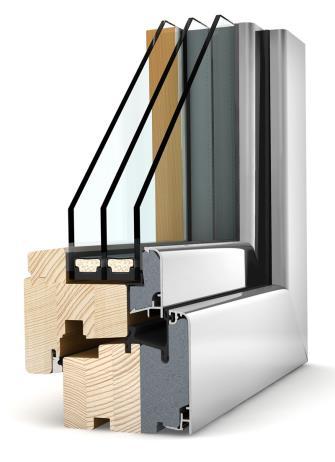
Triple glazed opening sash – timber frame with aluminium cladding and two seals (Source: Internorm) Multi-point locking mechanism (Source: Sashed)
This page summarises some of the key selection criteria when reviewing which doors to purchase.
Key selection criteria U-value – This describes the thermal performance of the door product. Consideration should be made to the U-value of the whole door unit. A U-value of 1.0 W/m2K should be used as a guideline. Glazed doors – If the door is glazed, then the glazing properties need to be considered. The g-value as well as the U-value needs to be considered as these impact energy performance and solar gains. Airtightness rating – The airtightness rating of the doorset systems should be reviewed, and high performance systems specified. Embodied carbon – The amount of carbon dioxide equivalent emissions generated in the production and manufacture of the door unit material should be considered.
Security – Consideration should be made to the security ratings when selecting the doors.
Performance ULTRA insulated timber door (Source: Green building store)

Triple glazed balcony door (Source: Internorm) Triple glazed timber doors )Source: Green building store)

Garage Door (Source: Hormann LPU67 Thermo M)
Find High Performance Door Products
The Passive House Institute Component database is a fantastic way of searching for high performing door products.
There are many types of insulation products which are appropriate based on their application. Insulation, and the systems used to support them are key to achieving low U-values. The following considerations should be made when selecting Insulation:
Key selection criteria Area for use – Where will the insulation be used (e.g. external wall, roof, floor). Thermal conductivity – How much heat the material conducts. The lower the conductivity, the better performing the product. Moisture and air permeability – Some insulation products allow water vapor and/or air to pass through them, and some don’t. It is important to understand their hygroscopic properties, particularly when retrofitting a pre-1919 building. Thickness – The thickness should be considered to ensure it achieves the required U-value and aligns with building setting out. For external walls, it is important to ensure that the products used to support insulation are available in the length required. Physical properties – Insulation can be rigid or not, and there are advantages to both. Consideration should be made for insulation installation on site and methods of construction.
Fire rating – The building regulations associated with fire rating and insulation should be consulted to ensure safe and compliant products are used in the correct areas.
Compressive strength – Some insulation may require a degree of compressive strength, and this should be considered (usually floors). Embodied carbon – The amount of carbon dioxide equivalent emissions generated when producing the insulation material should be considered.

Dritherm mineral wool insulation (Source: Knauf)

Insulating foundations (Source: Isoquick) Structural insulating material (Source: Foamglas Perinsul)
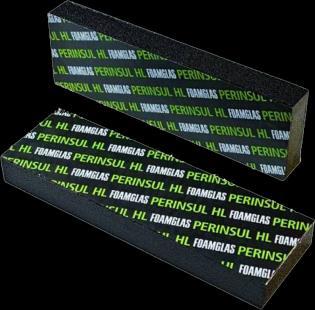
Finding High Performance Insulation Products
The Passive House Institute Component database is a fantastic way of searching for high performing insulation products.
Airtightness products
Main building elements The main building elements that form the airtight layer are the floors, walls, roof, windows/rooflights and doors. Concrete surfaces such as a floor or roof slab can usually be considered airtight. Masonry walls built from blockwork are not airtight, but can be made so with a suitable parge coat and wet plaster. Timber framed structures such as walls and roofs can use airtight OSB boards or specialized airtight membranes to create an airtight building element.
Connections Most connections between airtight elements of the building are made airtight through the use of specialist airtight tapes. These are designed and manufactured to last for many decades and should never be substituted for other construction tapes. Many different versions are available for different applications, for example fleece backed tapes that can be plastered over, double sided tapes for window frames, tapes for below ground use. Certain surfaces require application of a primer before taping, so make sure you know where these are on your project. Some sealants are also available for situations where tapes are not suitable.
Services Building services such as cables, pipes and ducts can be sealed with airtightness tapes, or specialised grommets that come in a range of sizes and styles. While grommets are more expensive, they can reduce the amount of labour required to achieve airtight service entries.


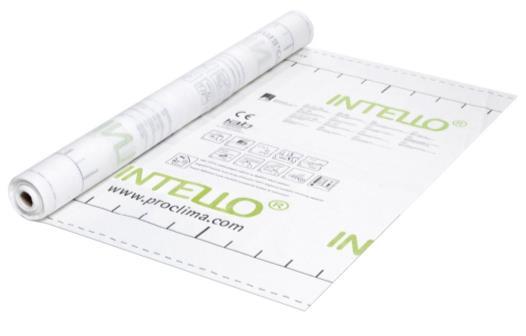

Large airtight surfaces within buildings are typically created from airtight OSB, parge coat and wet plaster applied over blockwork, concrete castings, or specialised airtight membranes. Do not use cheap polythene membranes, as these are fragile and lack the rigidity to tape without creases that cause leaks. (Source: Pro Clima)
Components of the airtight layer are primarily connected together with tapes. Appropriate primers should be applied to certain surfaces before taping to ensure adhesion. Airtightness grommets and specialised long-life sealants are also available to assist with more specialist junctions in construction. (Sources: Pro Clima, Siga)
Mechanical Ventilation with Heat Recovery (MVHR) There are many MVHR units available on the market. In practice, a building services engineer or professional will often be involved in helping you to select an appropriate unit. Key selection criteria to consider are:
Air volume flow rate (litres per second) – This must be high enough to meet requirements in Part F of the building regulations, and to mitigate overheating risk. Pressure drop (pascals) – This is how much pressure the MVHR can overcome and will influence your ductwork design. Noise rating (dB) – This needs to be low enough at the design duty not to cause a nuisance. In a utility space NR35-40 may be appropriate, however if it is near living space or sleep accommodation NR25 or lower should be targeted. Size – MVHR units come in varying sizes and shapes, some are more suited to cupboard installation and some are longer and flatter suited to a ceiling void. A key consideration for size is selecting a unit to suit the space available that allows for the filter to be easily changed. Specific Fan Power (Watts per litre per second) – This is critical to the energy efficiency of the ventilation system. A value of 0.9 or lower is recommended.
Heat recovery efficiency (%) – This defines how much heat can be recovered from the exhaust air. For best practice a minimum of 90% efficient should be targeted. Summer bypass – This automatically bypasses the heat exchanger so heat is not recovered when using the ventilation unit for cooling. Certification – Choose an MVHR unit that is Passivhaus certified to ensure quality and performance
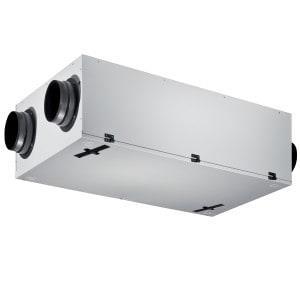
A range of Passivhaus certified MVHR units are available in both wall and ceiling mounted designs. The performance of Passivhaus certified units has been independently verified, which can be a good indication that a manufacturer is motivated to demonstrate the energy performance of their product. (Sources: Paul Heat Recovery, Zehnder, Brink)


Pre-insulated MVHR ducting is available from a range of manufacturers in both rectangular and round format. These systems can simplify duct installation between the MVHR unit and outdoor air terminals, improving energy efficiency. Combined intake/exhaust terminals are also available, which often help to minimise duct length, also increasing efficiency. (Sources: Domus Ventilation, Paul Heat Recovery)
Waste Water Heat Recovery Systems
Waste water heat recovery systems recoup heat Waste water heat recovery (WWHR) systems recover heat from shower or bath water as it is drained, this is used to warm the incoming mains water. The systems are very simple, and typically come in two forms, vertical or horizontal.
WWHR systems can be included in retrofit Although WWHR units are far easier to install for new housing, this does not mean they cannot be installed as part of retrofit. As long as there is access to the pipework serving the shower and suitable pipework lengths, a unit can be installed.
Key selection criteria Efficiency of recovery unit (%) – This represents the percentage of heat recovered by the MVHR system compared to actual heat required for the shower. The efficiency is greater for showers with lower flow rates. For vertical units, target greater than 55% and for vertical units, target greater than 25%. Other key considerations during selection and installation include shower flow rates, pipework connection sizes for the mains water and waste water, and water pressure. Manufacturer guides will provide acceptable ranges and details for their products.
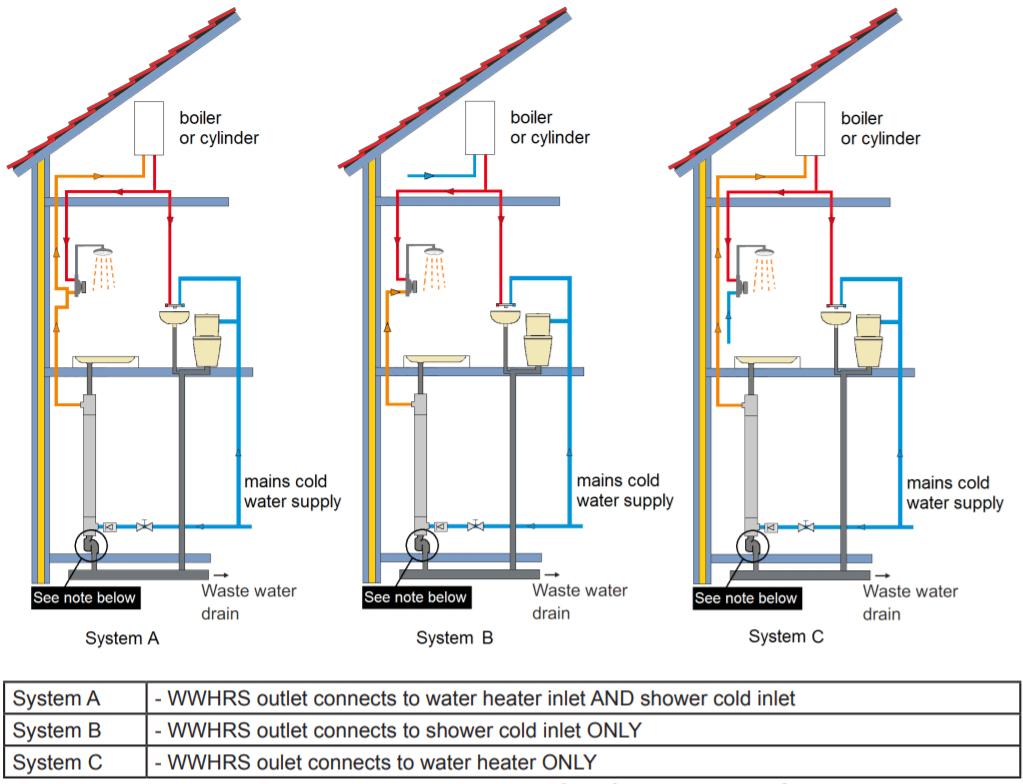
A diagram of installation configurations for waste water heat recovery. (Source: HeatraeSadia)
Selecting the right heat pump Sizing a heat pump is never simple. There is no one-size-fits-all as the heating demands of every property and family is unique. To get air source and ground source heat pump size right, the following things should be considered.
• Type/size of property • Level of insulation/heat loss • Size of radiators/underfloor heating • Desired indoor temperature • Seasonal outdoor/ground temperatures in your area
Key selection criteria
Maximum heating capacity (kW) - Heat pumps are given output ratings in kilowatts (kW) which represent how powerful a heat pump is. For heat pumps, bigger is not always better though: they should be sized according to the peak heating demand. Max heating capacity tends to range from 4 kW and 16 kW.
Minimum heating capacity (kW) - The minimum capacity of the system selected is as important as the maximum. A good heat pump has adequate turn-down to perform well during low-load conditions as well as peak conditions
Coefficient of Performance, CoP – The efficiency of a heat pump is expressed as ratio of the heat energy produced to input electrical energy. For example, if a heat pump produces 4 kWh of usable heat for a home and requires 1 kWh of electricity to do so, it has a COP of 4.
Seasonal Coefficient of Performance, SCoP - This is an average coefficient of performance taken across the entire heating system, and the main metric used to define the performance of a heat pump. Maximising heat pump efficiency The efficiency of heat pumps increase as the temperature difference between the heat source and system temperatures. To increase efficiency consider: Lower system temperatures - Whereas radiators typically require a minimum water flow temperature of 45-55˚C, underfloor heating can operate as low as 25-35˚C. Lower system temperatures also mean lower losses in conversion, storage and distribution of heat. Heat source - The temperature of the ground is roughly 10–13˚C all year round, so a ground source heat pump remains consistently efficient, unaffected by seasonal changes. An air source heat pump on the other hand is subject to fluctuating air temperatures. In the colder months, when there is the greatest demand for heating, they are at their least efficient.
Maintenance and warranty When correctly installed, heat pumps should require little maintenance and last for at least 20-30 years. If something does go wrong, it can lose efficiency fast, but this underperformance should be noticeable. Most heat pumps come with a 5-10 year warranty on parts and labour.
Heat Pump - Space Heating
Heat Pump - Domestic Hot Water Heat Pump Type Standard CoP Best Practice CoP
ASHP 3.50
Closed GSHP 2.50 4.50
Open GSHP
ASHP
Closed GSHP 2.0
5.50
2.50
2.50
Open GSHP 3.00
Efficient and fossil fuel free Air source heat pumps (ASHPs) absorb heat from the outside air, from temperatures as low as -15°C, to provide space heating and hot water. They run on electricity but are far more efficient at generating heat than conventional systems and therefore require less energy. Unlike gas and oil boilers, heat pumps tend to deliver heat at lower temperatures over much longer periods.
The two main types Air-to-water heat pumps are the most common and can be used with a wet central heating system. Because of the lower temperatures they work well with underfloor heating or larger radiators. Air-to-air heat pumps provide warm air directly to a room. They will not provide you with hot water as well.
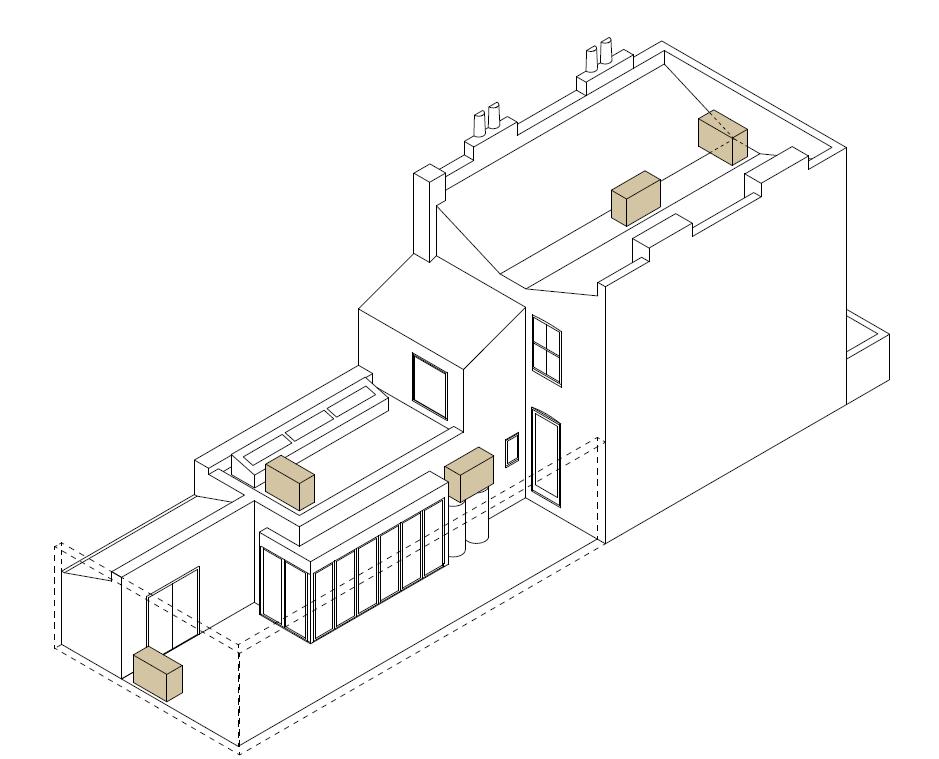
Heat pumps need a home, and you may need planning permission You will need a place outside the home where the external unit can be fitted to a wall or placed on the ground, with plenty of space around it for air flow. The external unit is often connected to an internal unit containing circulation pumps and hot water, which is usually larger than the average boiler. Although they might not take up much space, heat pumps may be visible. If permitted development rights cannot be used, a planning application may be required with a noise report.
Potential fuel bill savings Installing a typical system costs around £5,000 to £11,000. It will most likely reduce fuel bills if replacing a conventional electric heating system, but you are unlikely to save much on your heating bills if you are switching from mains gas, unless other energy efficiency and fabric improvements are made.
Roof location potentially viable if hot water tank on first floor, but does a roof valley constitute a flat roof ? PD terms not clear
On flat roof 1 m away from boundary is PD but remote from hot water tank.
Front yard not suitable for ASHP as within 1 metre of boundary so not PD
End of garden location likely to far from hot water location and within 1 metre of a boundary so not PD. Eventual selected location. Close to hot water tank and just 1 metre from boundary. In many cases this side return is likely to be too narrow. In this instance the heat pump does impinge on the view from the rear reception.
Potential locations identified by the architect for a terrace house (Source: Prewett Bizley Architects)
Benefits
1 It could lower fuel bills if replacing conventional electric heating
2 It could provide an income through the UK government’s Renewable Heat Incentive (only applies to air-to-water heat pumps) 3 Fossil fuel free and highly efficient therefore will reduce carbon emissions
4 It can provide hot water as well as space heating
5 It can be easier to install than a ground source heat pump
Efficient and fossil fuel free Ground source heat pumps (GSHPs) use a buried ground loop to extract heat from the ground which is then passed through a heat exchanger into the heat pump. This heat can be used to serve radiators, underfloor heating, warm air systems and hot water. Heat pumps run on electricity, but the heat they extract from the ground is renewed naturally. They are far more efficient at generating heat than conventional systems and therefore require less energy.
Space is required for the ground loop The length of the ground loop required depends on the amount of heat needed. If there is enough space, the loop can be laid horizontally in a trench. Where there is not room to do this, you can drill vertical boreholes, typically between 90m and 160m deep, but this requires specialist machinery and may increase the cost of installation.
A potential source of income Installing a typical system costs around £14,000 to £19,000. It will most likely reduce fuel bills if replacing a conventional electric heating system, but you are unlikely to save much on your heating bills if you are switching from mains gas, unless other energy efficiency improvements are made. If the system is part of a new development, combining the installation with other building work can reduce the cost of installing the system. You may be able to receive payments for the heat you generate using a heat pump through the UK Government’s Renewable Heat Incentive.

Different types of ground loop can serve the heat pump depending on the space available. (Source: Kete-RVS)
Benefits
1 It could lower fuel bills if replacing conventional electric heating
2 It could provide an income through the UK government’s Renewable Heat Incentive
3 Fossil fuel free and highly efficient will reduce carbon emissions
4 It can provide hot water as well as space heating
5 Minimal maintenance required
White goods The main energy consuming appliances to consider are dishwashers, clothes washers, clothes dryers, refrigerators, freezers and cookers. When purchasing from new, energy labels should be available. Compare these to best practice performance on the Top Ten UK site below, and choose the most efficient appliance that meets your needs. If purchasing second hand appliances, energy labels can often be found by searching the model number of the appliance.
Consumer electronics The energy consumption of consumer electronic devices is usually quite low. Possible exceptions include devices that produce heat, such as coffee makers with keep hot functions.
Audio visual Most new televisions and stereos are relatively energy efficient, however energy labels are available, so follow the same advice as for selecting white goods. Games consoles have powerful processors that can use reasonable amounts of energy, so should be turned off when not in use.
Standby consumption While electricity use in standby mode (also known as vampire load, or phantom consumption) used to be a significant concern, a series of increasingly stringent EU regulations over the past decade have effectively reduced it to negligible levels.
Resources The Energy Saving Trust’s ‘Top Ten’ is an excellent resource that lists the most efficient appliances currently available on the market.

Most appliances for sale in the UK will continue to carry EU energy labels. These were rescaled in Spring 2021 to adopt the original A to G system, ending the use of A* or higher ratings. Under the new scale, there are few A-rated appliances currently on the market – this is intentional, to allow room for future improvements to efficiency.
Electricity used by equipment and appliances is likely to be the largest end use of electricity in many net zero energy homes, so it is important to choose the most energy efficient appliances you can. Data based on energy modelling for a net zero energy new build home. Space heating Hot water
Fans & pumps Equipment & appliances Lighting
Solar PV panels Modern solar PV panels are a simple, mature and reliable technology. Most solar PV panels currently manufactured are based on wafers of monocrystalline silicon. Outdated polycrystalline technology is still available and should be avoided. Choose a panel with a 25 or 30 year linear power output warranty. Sizes vary, but 1,730mm x 1,040mm is typical. Expect a power output of 360 Watts per panel, though up to 400 Watts or more is possible. It does not usually cost much more to specify a higher power panel, so this is often a good option to consider, particularly if you plan on using a heat pump or electric vehicle in the future. Solar tiles are available, however standard format solar panels dominate the market for good reason. If you decide to install solar tiles, choose a company with a track record that will be around in the future to provide spare parts and support if required.
Inverters The inverter in a solar PV system conditions the electricity generated by the solar panels so it is safe to use in your home. Traditional systems used a single large inverter, however small ‘microinverters’ that mount behind each panel offer numerous benefits. They cost a little more than a single larger inverter, but can increase energy output up to 15% and are very reliable, with 25 year warranties available. Batteries
In many cases, batteries cost more to buy and operate than they will ever save you, though there are exceptions. Batteries also increase the complexity and embodied carbon of a solar PV system. Consider smart thermostats, solar hot water diverters and solar EV charging to increase self consumption of solar electricity.
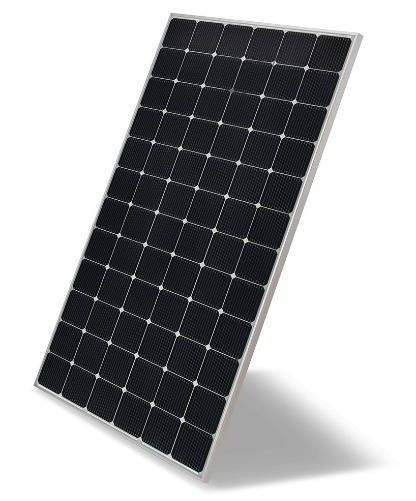
Specify monocrystalline silicon solar panels and microinverters for best long-term performance. Image shows a generic solar panel and an Enphase IQ7 microinverter. (Source: Enphase Energy)
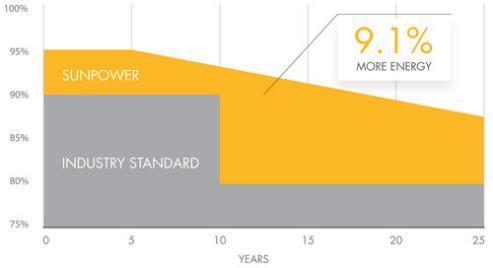
Power output warranties lasting 25 to 30 years are standard for solar photovoltaic panels. Look for a panel with a linear (rather than stepped) performance warranty for increased lifetime energy production. (Source: SunPower)



